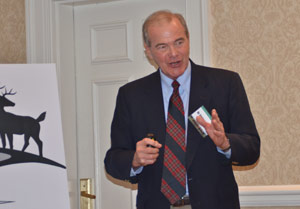Controlling the Controllable
Forage specialist shares 10 keys to a profitable forage program.
by Kasey Miller for Angus Productions Inc.

NASHVILLE, Tenn. (Jan. 31, 2012) — Forages are going to play a more important role in this country, said Garry Lacefield, Extension forage specialist with the University of Kentucky. He told participants in the Dow AgroSciences forage seminar in Nashville Jan. 31 that there will always be grain in America’s beef industry, but forages are going to become more important.
The seminar was hosted in conjunction with the 2012 Cattle Industry Annual Convention and NCBA Trade Show.
Growing global population; longer life expectancy; decreased meat consumption; and fewer farmers, farms and cows are all major changes the beef industry faces. Lacefield said the beef industry is sucessfully adapting to these changes because, despite them, beef production has increased and become more efficient.
Many challenges face the beef industry, including production costs, which rarely ever decrease; animal rights groups; enviromental issues; food vs. feed vs. fuel; health issues; and weather. Lacefield quoted a study by Rouquette et al. (2009) that reported that since 1984, there are 60% fewer forage/livestock researchers; 40% fewer forage/livestock teachers; 30% fewer forage extension specialists, with another anticipated 30% decrease by 2018. Another setback is that the USDA recently closed 259 facilities.
Lacefield said that to be profitable, income must be greater than expense. The challenge, then, is how to decrease expenses.

Garry Lacefield Photo by Kasey Miller
“As producers, we need to make sure we do the best job we can of controlling the controllable,” said Lacefield. Feed costs, and the amount and quality of forages are potentially controllable.
He reminded participants to not let the extremes harm the middle, but showed a study that compared grass-finished steers to grain-finished steers. This three-year study took 198 Angus steers, and finished them on either a corn silage-concentrate ration or pasture and harvested the steers at a similar age (18-month end point). The ribeyes were tested using the Warner-Bratzler Shear Force (WBSF) test. The study concluded that grass-fed beef was leaner, had increased omega-3 and conjugated linoleic acid (CLA) concetrations, increased antioxidant content and no difference in palatibility. The most important factor influencing tenderness was age, with beef from animals younger than 18.6 months having the greatest tenderness.
This study, he said, illustrates a great opportunity for the beef industry in that quality animal products can be produced on quality forages, within the right time period. To do this, he highlighted 10 keys to a profitable forage program.
- Know forage options and animal nutritional needs. The better we are at this, he said, the better we can produce a higher-quality animal.
- Establishment is critical. He said this is where many waste a lot of time and money. He said establish a method of seeding, and make sure the date, depth and rate of seeding are based on date from your area.
- Soil test, then lime and fertilize as needed. This affects the level and economic efficiency of forage production more than any other. Fertilizing and liming when needed help ensure good yields, improve forage quality, lengthen stand life and reduce weed problems.
- Use legumes whenever feasible. Legumes improve yield, quality, nitrogen fixation and summer growth. They also decrease the need for protein supplements.
- Emphasize forage quality. He said that several factors influence forage quality, but the single most important thing is the age of the plant when we use it.
- Prevent or minimize pest and plant-related disorders. Overgrazed and abused pastures get affected the worst by weeds and weather.
- Strive to improve pasture utilization. He suggested using rotational grazing, using the forage in a higher-quality stage, and using forage for more days of the year.
- Minimize stored feed requirements. He mentioned stockpiling forage, grazing crop residues or using both warm- and cool-season forages.
- Reduce storage and feeding losses. Reduce losses with good management, forage testing and ration formulation.
- Results require investments. Results are highly correlated to thought, time, effort and a certain amount of money.
“Is it possible to do better than we’ve done in the past? Without question, the data is there. We have the knowledge, the tools, the resources and the want to. We’re just going to have to make some changes,” Lacefield concluded.
-----------------------------
Editor’s Note: The above article was written under contract or by staff of Angus Productions Inc. (API). It may not be reprinted without express permission of API. To request reprint permision, contact the editor at 816-383-5200.
www.4cattlemen.com is an event coverage site provided by the editorial team at Angus Productions Inc. (API), publisher of the Angus Journal, the Angus Beef Bulletin, the Angus Beef Bulletin EXTRA and the Angus e-List. For questions about this site, to submit an article for our consideration, or to report a broken link, contact the editor at 816-383-5200; 3201 Frederick Ave., Saint Joseph, MO 64506.
API claims copyright to this web site as presented. We welcome educational venues and cattlemen to link to this site as a service to their audience.

